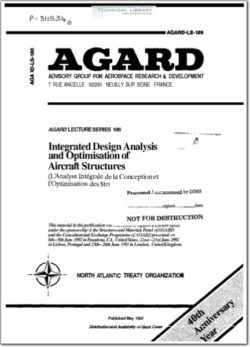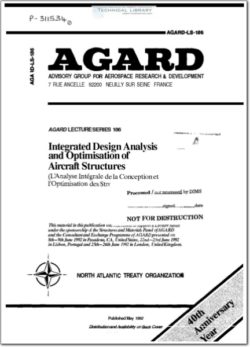AGARD-LS-186

- Version
- 301 Downloads
- 2.91 MB File Size
- 1 File Count
- April 26, 2016 Create Date
- April 26, 2016 Last Updated
Integrated Design Analysis and Optimisation of Aircraft Structures

In all this variety two aspects remain constant in all current structural
optimisation applications. First, the general problem which is characterised
by (1.1) remains unchanged so that the basic nature of the optimisation
problem is the same for all applications. Thus, the theory described in this
Lecture Series can be used in all design applications, Secondly, the
structural behaviour of the optimisation problem is always characterised by
the Finite Element Method. In many cases this has lead to the development of
optimisation modules which form an integral part of many commercially
supported F.E. packages Le. NASTRAN, SAMCEF, IDEAS, ELFINI, ANSYS, etc. In
addition, independent structural optimisation systems have been developed,
such as the DRA/SCICON STARS, MBB Lagrange, systems, which can be attached to
any existing FE system. These developments have resulted in Structural
Optimisation Methods being routinely available to users of modern CAD
systems.
The use and application of these methods in a safe and effective manner
requires some understanding of the underlying mathematical principles. As in
the case of the Finite Element Method the basic mathematics provides a
’tool—kit’ which is repeatedly used to develop solution methods. It is shown
in later sections that this process of developing solution methods use the
optimisation criteria as the basis for creating the up—date formulae which
are the solution algorithm drivers. Thus, this first part of the Lecture
Series, describes the optimality criteria, the associated duality theory and
the algorithms themselves.
The computer based numerical solution process for the problem defined at
(1.1) is in essence, simple. It requires that a repetitive formugoge is used
which starts with an initial estimate of the design variables x e R” and
systematically changes them until a set X is generated after 2 iterations
which satisfy (1.1).
| File | Action |
|---|---|
| AGARD-LS-186 Integrated Design Analysis and Optimisation of Aircraft Structures.pdf | Download |
Comment On This Post